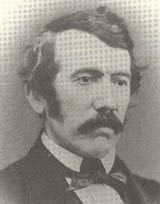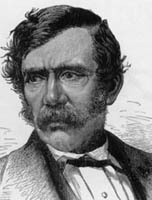Classic DACB Collection
All articles created or submitted in the first twenty years of the project, from 1995 to 2015.Livingstone, David (B)

 Dr. David Livingstone, the most famous Scottish explorer, who revealed Africa to nineteenth-century Europe, was also a missionary forerunner of modern Christianity in Africa.
Dr. David Livingstone, the most famous Scottish explorer, who revealed Africa to nineteenth-century Europe, was also a missionary forerunner of modern Christianity in Africa.
Livingstone was raised in poverty; the family of nine lived in a single room in a Lanarkshire cotton mill tenement. Working 14 hours a day while studying at night school, he prepared himself and saved what little he could until, in 1836, he was able to study medicine and theology at the University of Glasgow while still working part-time as a cotton spinner. In 1838 he went to London to offer his services as a medical missionary to the London Missionary Society (LMS), which he chose because of its nonsectarian character. Livingstone was a devote evangelical Christian; his own conversion came when he realized that faith and science were compatible.
In London, Livingstone completed his internship and through the LMS, met the South African missionary Robert MOFFAT, who attracted him to Africa. In 1840 he received his medical license, was ordained, and set sail for Cape Town. His first assignment was in Bachuanaland (now Botswana), where he was to found a mission station north of Moffat’s. Here he began what was to become his standard practice. He traveled into the interior and stayed with the local people until he learned their languages, preaching and studying the botany and natural history of the area. In 1844 he was badly mauled by a lion, so that he was forced afterward to fire his rifle from his left shoulder.
In between trips he ran his mission, building a chapel, setting up a printing press, preaching, and healing. In 1845 he married Mary Moffat, Robert’s eldest daughter, and began a family while moving about setting up new missions. The Royal Geographical Society (PGS) awarded him a prize and a gold medal for his discovery of Lake Ngami in the Kalahari Desert in 1849. In 1851 he reached the Zambezi River. When he returned to the mission, however, he found that the Afrikaners, smarting from his constant rebukes of them for practicing slavery, had burned down the mission and destroyed his home. In 1852, Mary and their four children were sent to Great Britain for their protection.
With the family’s departure, Livingstone embarked on a series of long explorations that were unprecedented at the time and that would take up the rest of his life. His determination was clear: “I shall open up a path into the interior or perish,” he said. Livingstone was convinced that Christianity, commerce, and civilization would deliver Africa from slavery and barbarism. He hoped to find a route to the Atlantic Ocean that would open legitimate commerce and undercut the slave trade while providing opportunities for missionary work. In 1852 he went north to the Zambezi and east to Luanda in Angola. On his return, he followed the Zambezi to the Indian Ocean, encountering along the way the spectacular falls called by the Africans Mosi-oa-Tunya (“the smoke that thunders”), which Livingstone named for Queen Victoria. In 1856 he returned to England a national hero and undertook a six-month speaking tour while preparing Missionary Travels and Researches in South Africa (1857), which made him financially independent and allowed him to provide for his family and resign from the LMS. England was deeply affected by a Christian religious revival at the time, and a series of Livingstone’s addresses at Cambridge University so fired young students that the Universities’ Mission to Central Africa (UMCA) was founded in 1860.
David Livingstone returned to Mozambique as British consul at Quelimane, charged with exploration “for the promotion of Commerce and Civilization with a view to the extinction of the slave trade.” The 1858 to 1863 expedition was equipped with a paddle-wheel steamer, six Europeans, and ten Africans. Nothing worked as expected; the ships (he went through three) could not navigate the Zambezi, Livingstone’s moody character caused dissension, and Mary died of fever in 1862, three months after joining David. The British recalled the expedition, and Livingstone sailed the last steamer, which was unsuitable for travel on the high seas, all the way to Bombay, India, to be put up for sale. Despite the sense of failure, the second expedition later proved among Livingstone’s most useful. He discovered both the Shire River and Lake Nyasa and exposed the atrocities of the Arab slave trade along the lake, especially at Nkhota Kota.
In 1865, back in England, Livingstone published Narratives of an Expedition to the Zambezi, and the RGS underwrote the costs of his next expedition, which was to search for the sources of the Nile River. He pushed further inland, discovering Lakes Mweri and Bagweulu in present-day Zambia. He reached Ujiji on Lake Tanganyika after great hardship, including Ngoni raids and desertion among his retainers. To avoid punishment on their return, the deserters spread the false rumor that Livingstone had been killed by the Ngoni. Nonetheless, the intrepid Livingstone pressed on until he reached the Congo River, the western-most point reached by any European explorer. At this juncture, after five years, the world considered him lost, and the London Telegraph and New York Herald Tribune, sensing a popular cause, sent the flamboyant journalist Henry Morton STANLEY to search for him. According to the legend, he met him in a dramatic encounter, doffing his hat and addressing the only white man supposedly within a thousand kilometers with the words: “Dr. Livingstone, I presume.”
Stanley reprovisioned Livingstone’s expedition and traveled with him around Lake Tanganyika, but the weak and ailing Livingstone refused to leave Africa with him. In 1873 his servants found him dead. They embalmed the body and carried it overland to the Indian Ocean, a journey of nine months. He was buried in Westminster Abbey in a solemn national funeral. Livingstone’s achievements were notable. His discoveries - geographical, botanical, medical, and social - were far-reaching. Most significantly, however, his explorations made him a forerunner of Western imperialism.
Norbert C. Brockman
Bibliography
Lipschutz, Mark R., and R. Kent Rasmussen. Dictionary of African Historical Biography. 2nd edition. Berkeley: University of California Press, 1986.
Dictionary of National Biography. London: Oxford University Press, 27 volumes, 1921-1959.
The New Encyclopedia Britannica. 15th edition. Chicago, IL, 1988.
Encyclopedia of World Biography. Palatine, IL: Heraty, 17 volumes, 1973-1992.
Additional reading: Humble, Richard. The Travels of Livingstone (1991) [young adult]; Murray-Brown, Jeremy. Faith and the Flag (1977); Seaver, George. David Livingstone (1957).
This article is reproduced, with permission, from An African Biographical Dictionary, copyright © 1994, edited by Norbert C. Brockman, Santa Barbara, California. All rights reserved.



